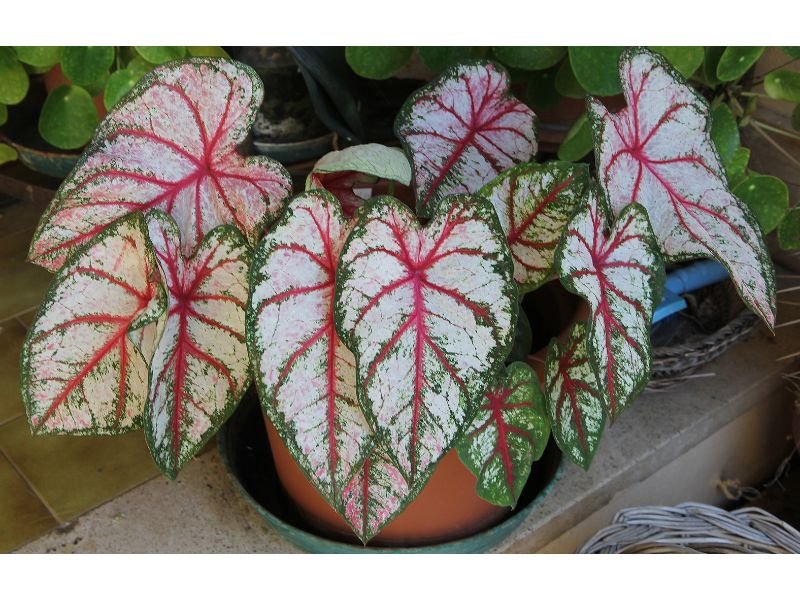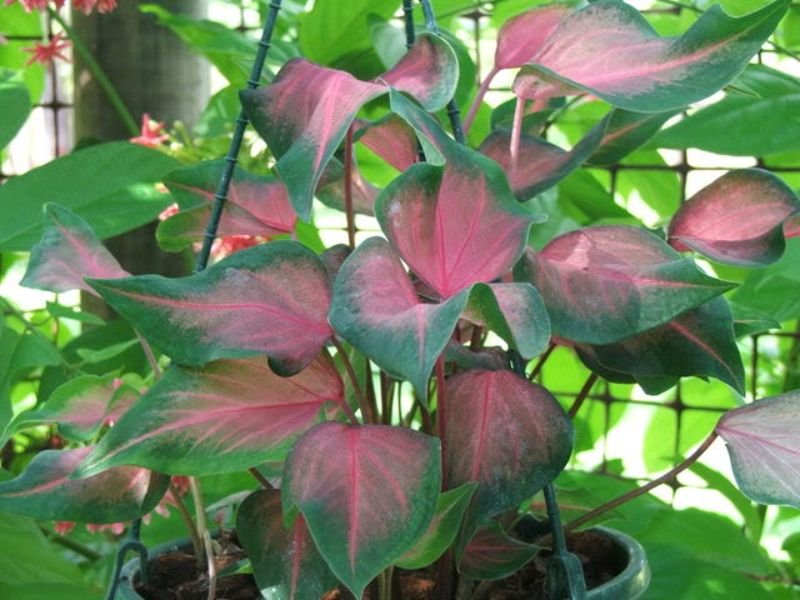Caladiums are definitely not your average houseplants. With their striking colorful foliage, these tropical beauties can add a touch of exotic flair to any garden bed. While they’re one of the easiest houseplants to maintain, growing caladiums as houseplants do require some extra attention to keep them at their prime. In this section, we gather up all you need to know to thrive caladiums in your home, so let’s dive in!

Table of Contents
Basic Plant Info
Common Name(s): Angel wings, caladium bicolor, Heart of Jesus, taro plant, fancy-leaved caladium
Scientific Name: Caladium, caladium bicolor
Family: Araceae
Country of Origin: Central and Southern America
Growing Zones: 9 to 11
Size: Approximately between 1 to 2 feet (30 to 60 centimeters) tall indoors, 3 feet (90 centimeters) tall or more outdoors
Toxicity: Toxic for humans and pets, contains calcium oxalate crystals than can be harmful if large quantities are eaten
Color(s): Shades of green, pink, white, yellow, burgundy, magenta
Foliage and Flower Shape: Heart or wing-shaped with arum-type flowers
Everything You Need To Know To Grow Caladiums As Houseplants

Light
One of the most critical and challenging things when growing caladiums as houseplants is to provide the right light. While numerous caladium cultivars can survive under direct sunlight for about 2 to 6 hours or more per day, most caladium prefers bright but indirect light to thrive.
If possible, avoid exposure to bright and direct sunlight as it could be too harsh and might burn their delicate leaves. When grown indoors, the best area to grow caladiums is near a window with filtered light.
Watering
When it comes to watering caladiums, there’s only one general rule. Caladiums such as houseplants or outdoor garden plants require plenty of moisture but are not too overly soaked and soggy. Keep track of your watering schedule, most caladiums will do just fine with once or twice a week watering.
Give them water when the first 2 or 3 inches (5 or 7 centimeters) of the topsoil is dry. Avoid overwatering at all costs as it can lead to root rot and even manifest fungal-related diseases and pests.
Soil
Fortunately, thanks to their increasing popularity, it’s not difficult to find the best caladium soil mix indoors to grow them as a fancy houseplant. All caladium varieties are die-hard fans of well-draining and high organic matter soil.
A good potting mix will include a proper combination of peat moss or orchid bark, perlite, and compost or manure. This tropical plant also loves loamy or sandy types of soil that are slightly acidic, with the best pH level ranging from 6.0 to 6.5. They can tolerate a pH of 5.5. Make sure to only use a balanced potting mix that is created especially for caladiums and aroids.
Temperature and Humidity

As natives of tropical rainforests, it’s no surprise how caladium has evolved to survive well in warm and humid areas. Ideally, the right temperatures for caladium must be between 65ºF (18ºC) to 85ºF (29ºC), with humidity levels set for at least 60% to 80%.
This plant should be protected from sudden temperature drops, winter, and frost, as they might go dormant or even die.
If you live in an area where humidity is scarce, try to increase the humidity level by using a commercially available humidifier or go more eco-friendly by using a tray of water and placing them near the plant.
To incorporate more humidity, try misting the foliage regularly or simply move them to a more humid area. However, caladiums as houseplants are prone to pests and fungal-related problems so you might want to carefully watch and accelerate the temperature and humidity levels.
Pruning and Propagation
The process of pruning for caladiums is necessary to help improve the plant’s appearance and promote new, healthier growth. You can remove the diseased and damaged leaves, including browning and yellowing leaves, with clean and sharp gardening scissors.
Although seldom seen growing indoors, removing caladiums’ blossoms also helps to encourage more foliage growth. Keep away from over-pruning your caladium as it can lead to stunted growth. If you remove too much foliage from the plant, it can disturb its ability to photosynthesize.
Caladiums, as houseplants can be propagated using two different methods, stem cuttings and by dividing the tubers. To propagate using stem cuttings, the best time to do this is during summer. Pick a healthy, disease-free stem and plant it in a new pot with fresh potting soil. Water and keep the temperature as usual.
Meanwhile, if you’re more interested in propagating by dividing the tubers, you can do this process in early spring. First, gently remove the caladium from its pot and separate the tubers that should have at least one ‘eye’ or the growing point.
Finding the ‘eye’ is crucial as this is where the new caladium will grow. After successfully finding the perfect tubers, plant them in fresh potting soil and repeat the watering process as usual.
Common Problems
Typically, caladiums are not subject to non-manageable problems, including pests and diseases. Pests such as aphids, mealy bugs, spider mites, and scale insects can be cured by using rubbing alcohol, insecticidal soap, neem oil, or horticultural oil.
To prevent further spreading, never water the diseased caladium from the top, as the splash of water can be the medium for more infection. Isolate the plant first and remove all the pests and diseased foliage or stems before using any treatment.
Problems such as root rot, browning or yellowing leaves, as well as crispy leaves–which is a sign of leaf burn, might as well infect your caladium.
Providing the right growing conditions is the key answer to treating and preventing these unwanted problems. Most importantly, make sure to keep a clear head as most problems with pests and human error-related problems in caladiums are treatable.
Dormancy

If you’re wondering, is dormancy or ‘resting’ during the cold season usually in the world of caladiums? The answer is most likely, yes! Caladiums might go dormant if the temperature suddenly drops to 60ºF (15ºC) or lower.
If the plants would likely come face to face with the winter season, it’s crucial to move them indoors in warm and humid temperatures to protect the plant. During their dormancy, caladiums can lose a little foliage or even stop growing at all, so reduce the water intake. It’s best recommended to not feed them fertilizers in this phase.
Caladium Indoor Benefits
Thriving caladiums as houseplants will provide not only aesthetically pleasing scenery but also surprisingly good health benefits! Caladiums, identical to their aroid cousins, are known as air-purifying plants. These gorgeous foliage plants could help you reduce harmful substances and pollution, as well as increase the amount of oxygen–all can have a direct impact on our overall’s health.
Caladium Lifespan: Is Caladium A True Perennial?
Caladiums are not true perennials, as they can be grown as annuals in some areas. They can grow year-round, but in less-warmer environments, they may not survive through the harsh winter. If the plant dies off at the end of its growing season, worry not. You can replant the caladium by performing the recommended propagation method.
Can Caladium Grow in Water?
Caladiums can be grown in non-chlorinated or filtered water, however, this is not highly recommended. Water is not an ideal growing condition for most caladium varieties as being soaked for too long in water can increase the chance of root rot and any other problems.
Wrapping Up
Not too demanding to maintain, and providing lustful and colorful heart-shaped leaves with air-purifying benefits, caladiums as houseplants are perfect for both novice and expert plant enthusiasts. Be sure to give them the right growing conditions, including bright indirect light, well-draining soil, warm temperature, and high humidity, to see the beauty you can enjoy at any moment.

New author in the hood. Loves gardening and flowers are my spirit animals (yes I know they are not animals but I insist). I will be covering most of the flowers’ topics here and occasionally random though as well.






